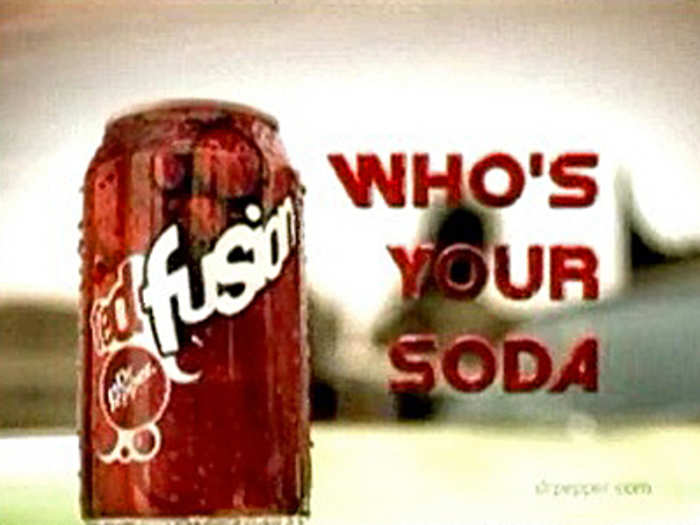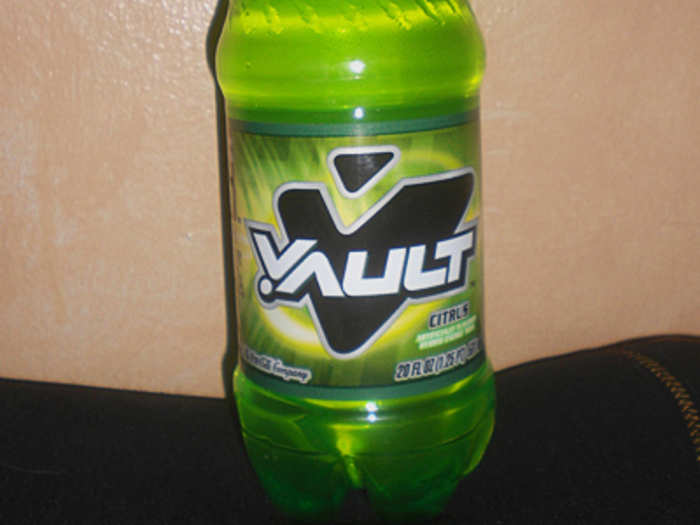19 failed soda brands you'll never taste again
Pepsi Blue

Orbitz

Orbitz is the only drink on this list which contained floating lumps of solid food. It was made by the Clearly Canadian Beverage Corporation, which called it a "texturally enhanced alternative beverage," when it was released in 1997.
Not enough consumers went for the gimmick and the lava lamp-resembling drink was discontinued within one year, according to Time.
In July 2013, Clearly Canadian announced on Facebook that it was considering bringing back the semi-solid soda drink in small batches each year. However, the drinks company's website states that it is still researching whether this is possible.
"Have you seen a bottle from 1997? The balls are still floating! NO JOKE," the website says.
Sprite Remix
Coca-Cola's Sprite Remix popped up in 2003, and it quickly developed a rabid fanbase. Coke would expand its Spirte Remix flavors twice in the next two years, adding Berryclear and Aruba Jam to its portfolio following the original Tropical.
However, in 2005, Coca-Cola decided it wasn't performing well enough and killed the brand — at least in the American market.
OK Soda

OK Soda launched in 1993 and was completely gone by 1995. In fact, the drink failed so quickly that it never went completely national, and Coca-Cola decided to nuke the whole project just seven months after its release.
It was backed by a strange marketing campaign which tried to be wholly transparent, ignoring the taste of the drink, and purely promoted the "feeling."
Fans stayed with OK Soda after it was discontinued. Various internet communities kept the OK Soda going, and people collected a lot of the brands' advertising and other assorted paraphernalia associated with it.
Josta

Josta became the first energy drink to make its way into the Coke vs. Pepsi cola wars when it was put on shelves in 1995. PepsiCo's brand used the active ingredient guarana — along with caffeine — to provide an energy boost.
The brand was shut down in 1999, never to return. Its fans wouldn't give up on it though, and there's still a Save Josta website that exists today, with its supporters endlessly yearning to taste their Josta again.
Red Fusion

In 2002, Dr. Pepper Red Fusion became the first new flavor Dr. Pepper ever added in its 120+ year history. The drink was predominantly cherry-flavored but was also combined with a bunch of other fruit flavors, and it failed spectacularly.
Despite the marketing power behind it, Dr. Pepper ceased producing Red Fusion nationally less than a year after launch, though it lingered until 2004. Many complained about the taste, and how it didn't stand up to its sister brand Dr. Pepper.
7-UP Gold

The formula for 7-UP Gold was developed by The Dr. Pepper Company, and brought out by 7-UP soon after the two drinks giants merged.
Unfortunately, the drink was a complete disaster and it failed to last more than one year after its launch in 1988. This could have had a lot to do with the taste, which was described as "cinnamon-spicy" and it had a "reddish caramel hue."
According to a New York Times article from 1989, 7-Up's chief executive at the time, John R. Albers said: ''I'll be honest. It's a failure."
Slice

PepsiCo introduced lemon-lime Slice in 1984 and it did well enough to get the company to produce more than 12 variations of the brand.
Slice's brand began to lose its luster over time, until it was finally replaced in the early 2000s by the similar Sierra Mist. Now the flagship and most of the other flavors have all but disappeared, but you can still get some variations like Diet Slice Orange at Walmart.
DnL

Introduced in 2002, Cadbury Schweppes' short-lived dnL brand was an attempt to pull consumers away from Pepsi's ever-dominant Mountain Dew beverage.
A valiant effort, but it didn't work. dnL failed to gain traction with Mountain Dew drinkers, and the brand was killed in 2005.
Its legacy lives on though because of the interesting marketing tactics used. dnL's marketing went with the "upside down" theme. Unlike the 7-Up Gold disaster 15-years earlier, dnL sought to truly become the opposite of 7-Up, and it wanted people to know that.
Citra

Coca-Cola started up the Citra brand — a caffeine-free grapefruit soda — in 1996. It's similar to Fresca and Squirt, and managed to get itself a decent following.
But it became evident that the Citrus brand wasn't going to work out, so it went on hiatus.
Coke eventually decided to rebrand it into its stronger Fanta stable, morphing the drink into Fanta Citrus.
Vault

Coca-Cola's Vault brand was promoted as a hybrid energy drink-soda when it was brought to market in 2005 to compete with Pepsi's Mountain Dew.
It was directly paired up with Pepsi's citrus brand, and Coke even responded to the development of Mountain Dew: Code Red by coming out with a drink called Vault Red Blitz in 2007.
Vault survived for six years and developed a significant fanbase — like its predecessor Surge — before getting cut by Coke.
Hubba Bubba

Hubba Bubba Original Bubble Gum Soda began life in 1987 after Steve Roeder created it, using a snow cone flavoring. However, the drink was discontinued before the 90s.
The pink-colored drink also came in a diet flavor.
The company which produced the drink, Novelty Beverage, acquired license rights from the Wrigley company and it was sold worldwide, according to Steve Roeder's LinkedIn page.
Crystal Pepsi

Clear things were a fad in the early 1990s, so Pepsi tried its luck with Crystal Pepsi. The drink was caffeine-free, and the idea was that since it's clear, people would equate it with thoughts of purity and healthiness.
It worked quite well out of the gate, and even prompted a response from Coca-Cola. But soon after, consumers shied away from it, and Pepsi was forced to discontinue it in 1993.
Yum! Brands chairman David Novak explained in a 2007 interview with Fast Company, "I still think it's the best idea I ever had, and the worst executed. A lot of times as a leader you think, 'They don't get it; they don't see my vision.' People were saying we should stop and address some issues along the way, and they were right."
Tab Clear

Tab Clear was Coca-Cola's response to Crystal Pepsi during the clear soda fad. Unlike Pepsi's offering, Tab Clear actually contained caffeine.
Hitting stores in 1992, the brand went international just two weeks after its launch, but it was doomed from the start. Once consumers got sick of the fad, it would tank like the rest of the clear sodas.
And that's what happened. Coke shut down Tab Clear by 1994, but it still maintains an important spot in soda history.
Coca-Cola BlaK

Coca-Cola BlaK, a coffee-flavored cola, was first introduced in France before making its way to the U.S. market in 2006.
The American version was sweetened much differently from its international counterparts. The French version used sugar, while the American one replaced it with high fructose corn syrup, aspartame and acesulfame potassium.
Consumers didn't go for it, and Coke stopped selling the drink in the U.S. in 2008.
Mr. Green

Mr. Green's 2002 release was Pepsi subsidiary SoBe's only foray into the soda business, and it failed in a hurry. The Dr. Pepper-like drink was colored green, infused with ginseng and bore the SoBe lizard mascot on the bottle.
The drink just didn't work with consumers and SoBe halted production in 2003. SoBe's other beverage lines have taken off since then, and now that soda brand has fallen off the Earth, finding anything branded Mr. Green is pretty rare.
New Coke

The infamous New Coke remains a cautionary tale about why you shouldn't tamper with strong brands.
The reformulated version of Coca-Cola Classic launched in 1985 to help fight off the hard-charging Pepsi. It prompted outrage among hardcore Coca-Cola Classic fans, and less than three months later, Coca-Cola went back on its decision.
People are still seeking out New Coke, which was later sold in foreign markets under the name Coke II until it was permanently shut down in 2002.
Jolt Cola

Jolt Cola, created in 1985, was an outsider to the eternal battle between Coke and Pepsi. The flagship drink of Wet Planet Beverage gained serious traction by marketing itself as a "maximum caffeine" alternative, and its appearance in "Jurassic Park" added to its mystique.
In 2011, the company filed for Chapter 11 bankruptcy protection following a dispute about its bottles. After restructuring, the company relaunched and rebranded the Jolt flavors to Jolt Energy.
You can actually still get Jolt Cola brand drinks in glass bottles on the West Coast, but it has yet to regain its status from its glory years.
Thanksgiving Dinner Soda

In 2004, Jones Soda brought out fruitcake soda, green bean casserole soda, mashed potato & butter soda, cranberry soda, and turkey & gravy soda.
The company specializes in unconventional fizzy-drink flavors.
According to Time, a portion of the proceeds were given to charity in 2004. The full range was not brought back the following year, but Jones Soda did trial other savory flavors in 2006, including sweet potato, dinner roll, and pea.
Popular Right Now
Advertisement